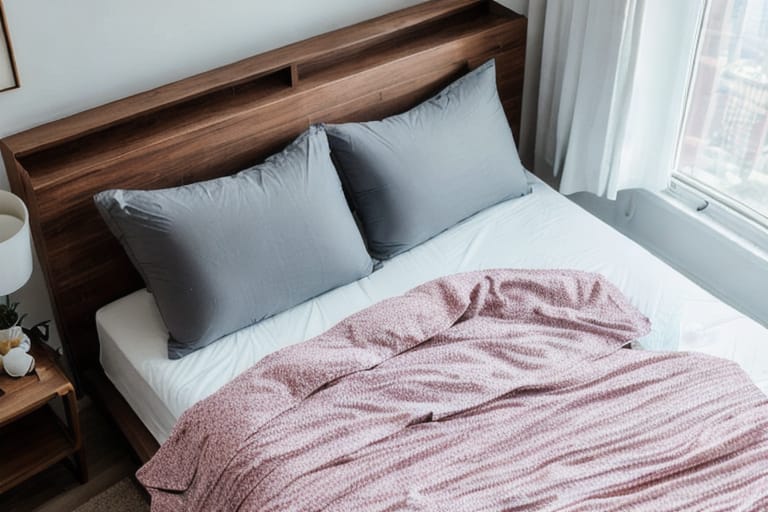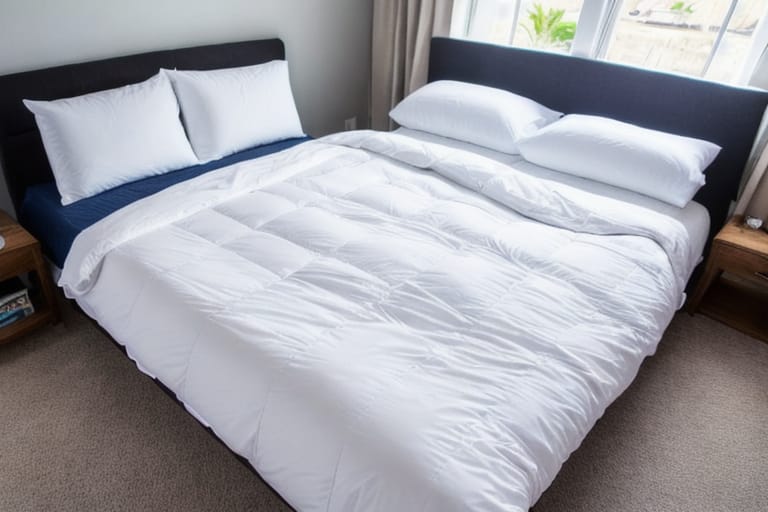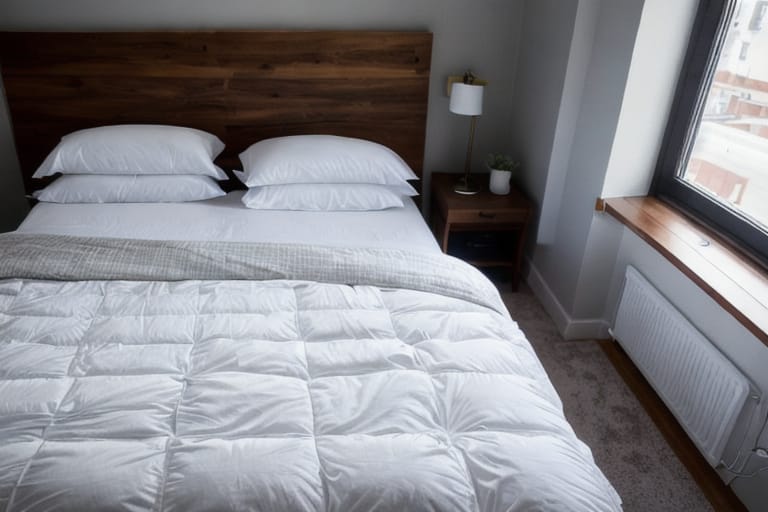Have you ever snuggled up under a down comforter on a cold winter night and wondered, what makes this magical blanket so warm and puffy? As you sank into its cloud-like softness, you may have questioned what exactly those ethically sourced feathers are that create such an amazing sleep experience.
This beginner’s guide will uncover the science behind down comforters and detail what materials make them such an exceptional type of bedding. We’ll take a look at:
- Downfill power and different feather types
- Construction methods like baffle boxes
- The role of the outer shell and fabrics
- How to pick the perfect level of fluffy warmth
- Size, care, and maintenance recommendations
- How down compares to alternatives like synthetics
- Plus popular brands, misconceptions, and more!
So snuggle up under your favorite cozy down comforter, and let’s get started!
A Fluffy History
While today we can’t imagine our beds without down comforters, these puffy wonders trace their origins back centuries…
Down comforters as we know them emerged in Europe during the late Middle Ages. Eiderdown comforters were made from the breast feathers of the Eider duck.
Goose and duck down replaced rare Eiderdown over time. Innovations like baffle box stitching emerged in the 20th century to prevent down shifting. This allowed the fluffiness and insulation to spread evenly across the comforter.
Nowadays, down comforters range from budget-friendly picks under $100 to luxury options from elite brands costing over $1000! From twin to California king sizes, there’s a perfect down comforter for every preference and budget.
Feathery Features: Benefits of Down Bedding
Why choose down when alternatives like cotton, wool, and synthetics exist? Down comforters shine for these five key benefits:
1. Lightweight Warmth
Down insulation traps heat extremely well for its low weight. The clusters let pockets form so your body heat gets trapped in the spaces between. This means no sweating under uncomfortable heavy blankets!
2. Soft as a Cloud
The tiny down feather clusters make the fill lofty with tons of air pockets. This allows down comforters to compress when you slide underneath and then puff back up around your body like a fluffy cloud.
3. Long Lasting Durability
With proper care and storage, quality down comforters can last over 10 years. Thanks to the natural resilience of down, it keeps insulating properties and rebounds well from compression.
4. Promotes Restful Sleep
The breathable fill of down allows moisture and heat to pass through, keeping you dry and comfy. This helps regulate your body temperature so you sleep soundly through the night.
5. Aesthetic Appeal
From traditional all-white bedding to modern colors and prints, down comforters have a certain luxurious aesthetic no synthetics can match.
Clearly down has some exceptional properties that set it apart from other types of bedding fill. But what exactly is down, and what specific materials go inside these blankets?
Delving Into Down: Goose vs Duck
When we talk about a down comforter, we mean the soft feather fill inside is what creates the warmth and billowy puff. This special substance comes from ducks and geese. What’s the difference between the two types?
Duck Down
- Typically larger compared to clusters
- Provides great insulation at a lower price point
- Best suited for budget or lightweight comforters
Goose Down
- Smaller clusters than duck down
- High loft and durability over time
- Required for premium comforters with 600+ fill power
- Considered superior quality to duck
Now that we know where down comes from, how do manufacturers actually measure and assess this fluffy fill? This is where fill power comes in.
What Is Fill Power?
Fill power represents the space one ounce of down takes up in cubic inches. It measures the air pockets that get trapped between feather clusters and provide insulation.
- Higher fill power means more trapped air and warmth
- The lower fill power indicates heavier, more tightly-packed feathers
Most quality down comforters have fill power between 550 to 900. Budget picks often range from 300 to 600, while luxury comforters report 700 and above.
As fill power rises, so does the price tag. But increased loft and durability make it worthwhile for many sleepers seeking premium bedding.
Now that we know precisely what comprises down and how it gets assessed, how do manufacturers construct the whole comforter package?

Down + Fabric: Comforter Construction
Creating a down comforter requires a precision design to get that fluffy cloud sensation exactly right:
Step 1) Source ethically-harvested geese or duck feathers
Step 2) Thoroughly clean and sanitize down to prep for filling
Step 3) Calculate the fill weight to match the size and desired warmth level of the comforter
Step 4) Choose outer shell fabric based on breathability, softness, and appearance
Step 5) Sew together fabric with a box baffle or stitch-through box design
Step 6) Insert down into sections and seal edges to prevent shifting
We’ll unpack exactly how baffling and outer shell choices affect performance next.
Baffle Box Construction
The most coveted down comforters use baffle box construction to create separate fabric compartments that hold feathers in place. This more complex design prevents the fill from shifting around.
There are a few main types of baffle box stitching:
- Simple baffle boxes have single vertical walls between each down section
- Double baffle boxes contain horizontal and vertical walls for maximum down stability
- Sewn-through baffle boxes feature walls stitched fully through front and back with holes only at corners
The sewn-through method allows some fill to travel between baffles. So full baffle box designs excel at keeping insulation evenly distributed.
Outer Shell Fabrics
The exterior fabric influences the down comforter’s durability, breathability, warmth level, and overall feel:
- Cotton excels in breathability but lacks durability over time
- Silk provides sensuous softness although more delicate
- Polyester brings moisture-wicking features but can sleep too warm
- Cotton-poly blends balance breathability with durability
Thread count indicates quality, with higher numbers meaning more finely woven material. Counts between 300 to 400 optimally balance softness, breathability, and strength.
Special downproof fabrics have very finely woven structures to prevent fill from escaping through the shell. This maintains your comforter’s loftiness year after year.
Size, Warmth, and Allergy Considerations
When selecting a down comforter, tailor your choice around sleeping needs:
Size: Pick from standard mattress sizes like twin, full/double, queen, or king. Oversize selections like an oversized king or California king ensure full bed coverage.
Warmth: Lightweight options work well for summer or hot sleepers. Warm and extra-warm levels provide toasty insulation during chilly seasons.
Allergies: Those sensitive to feathers should choose hypoallergenic designs with down alternative fills and tightly woven, downproof shells.
Caring for Your Comforter Over Time
To enjoy your down comforter’s amazing properties for years to come, follow these care guidelines:
- Fluff frequently – Puff up the comforter after making your bed and before turning in for the night
- Spot clean stains – Use mild detergent and a wash cloth dampened with cool water
- Wash yearly or less – Only do a full gentle wash cycle if heavily soiled
- Air dry thoroughly – Always line dry your comforter in the sun, never machine dry
- During winter storage, leave it in a breathable cotton cover or mesh bag
Avoid harsh chemicals or cleaners to prevent stripping the feather’s natural oils over time. With regular fluffing and gentle handling, your comforter will last over a decade.
How Down Compares to Synthetic Alternatives
While down still reigns supreme for warmth, coziness, and durability, alternative down-free options continue gaining popularity. Let’s see how they stack up:
Fill Material
- Natural down from ethically-sourced waterfowl
- Synthetic alternatives like polyester, microfiber, or rayon from petroleum-based textiles
Warmth & Weight
- Natural down provides more insulation ounce for ounce
- But advanced synthetics nearly match down’s heat efficiency nowadays
Loft Over Time
- The resilient structure of feather clusters maintains loft well
- Synthetics tend to compress and flatten more rapidly
Price Considerations
- Synthetics offer decent quality for lower prices
- Down carries a higher upfront cost but lasts significantly longer
While costs continue to drop, synthetics still can’t fully replicate the unparalleled coziness of natural goose or duck down…at least not yet!
Top Down Comforter Brands on the Market
From budget picks to elite luxury options, which down comforter brands lead the way with quality construction, ethical sourcing, and customer satisfaction?
Brooklinen shines with simple but well-constructed mid-range choices certified by the Responsible Down Standard.
Parachute Home takes the lead for premium comforters made ethically in factories with safe, fair working conditions.
East Coast Bedding’s White Goose Collection excels at hotel-style indulgence balancing quality materials with reasonable prices.
Serta and Pacific Coast rank as top-rated among more affordable down comforters available from big box stores.
Snowe Home delivers sustainably produced, allergen-free comforters combining natural and synthetic down alternatives.
Down Comforter Misconceptions
Despite their reputation for luxury, several myths about down comforters turn many customers off from these bedding wonders. Let’s clear up a few fact from fiction:
Myth: Down requires specialist professional cleaning costing major $$$
Fact: Frequent fluffing and gentle home washing every few years keep down fresh and lofty
Myth: Feathers constantly leak out of the shell leaving mess all over
Fact: Modern comforters made with tight-woven, down-proof fabrics nearly eliminate fill loss
Myth: Without a duvet, or decorative cover a down comforter looks plain and boring
Fact: Many designers offer stylishly stitched down comforters in colorful fabric patterns ready to take center stage
Hopefully clarifying some fiction behind down helps more sleepers consider these unbeatably cozy options!

Final Tips for Choosing Your Dream Down
We’ve covered a lot of ground exploring the science, construction, and care behind these luxurious bed blankets. To close, here are key tips to remember while shopping:
- Seek fill power of 600+ for premium quality and longevity
- Select tighter-woven, down-proof shell fabrics using cotton, cotton-blend, or lightweight polyester materials to balance durability with breathability
- Match the size, warmth level and features to your personal sleeping needs and bedroom style
- Check for certifications from reputable groups like the RDS that indicate responsible sourcing
- Read reviews and narrow your choices down to 2-3 options before deciding
- Make sure retailer specifies policies on returns, warranties and trial periods before purchasing
Have more questions about picking the perfect down-filled wonder? Contact our sleep experts anytime for guidance in customizing your comforter.
Frequently Asked Questions About Down Comforters
What is the average price of a down comforter?
Prices range widely, but plan on spending $100 to $300 for a quality queen-sized down comforter with decent fill power and baffle box construction. Luxury options with higher fill ratings exceeding 700+ and premium outer shell fabrics run $400 and beyond. More budget-friendly comforters cost below $100 but compromise on fill quality and longevity.
How do I know if a down comforter will keep me warm enough?
Pay attention to the warmth rating specified by manufacturers to best match your needs. Choices typically come in light warm, all-season, or ultra warm / extra warm varieties. You can further customize based on fill power, shell materials, and single vs double baffle box construction.
What’s the benefit of using a duvet cover with my down comforter?
Duvet covers not only provide decorative style to your bedding, but also prevent body oils and spills from degrading your comforter’s outer shell over time. So using a removable duvet cover adds an extra layer to protect your investment in the comforter itself. Just take the cover off 2-3 times a year to gently wash and your down bedding will last for years.
How often should I wash my down comforter?
Only launder your down comforter once every 2 to 3 years if possible. To remove dust and refresh in between, simply shake your comforter outdoors and spot clean stains gently as needed. Frequent cleaning risks stripping the natural oils in down and decreasing insulation over time.
Is down or synthetic fill better for people with allergies?
Those sensitive to feathers should choose a hypoallergenic down alternative comforter with a microfiber polyester fill and tightly-woven outer shell. Synthetic fills avoid concerns related to dust mites or dander found more often with natural down products.
What’s the best way to store a down comforter?
During warmer months, avoid cramming your comforter in a stuffed closet! Allow breathability by leaving it inside a lightweight cotton or mesh storage bag instead of plastic. Store flat if possible or loosely folded to allow the baffle box sections room to expand back to full loft when taken out next winter. Proper storage helps extend your comforter’s lifespan.
How long can I expect a quality down comforter to last?
With a high fill power of 600 or above, baffle box construction, and tight-woven downproof shell, your investment should last over 5 years even with regular year-round use. Luxury options meeting these standards often last 10+ years with proper maintenance like fluffing, duvet covers and gentle cleaning methods.








